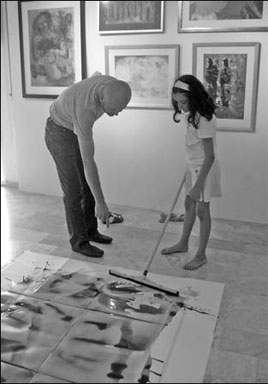Life and Leisure
Works of art are part of the treatment at Beirut clinic
By Fadia Azar (China Daily)
Updated: 2010-10-04 07:39
 |
Large Medium Small |
When Jordanian artist Khaldoun Daoud entered the Rizq hospital, in Beirut, for the first time to visit his friend's daughter, he came up with the unusual idea of turning the clinic into a fine arts gallery.
Hospital officials welcomed Daoud's scheme, and they quickly set a time frame to implement it. "People come to Beirut to spend the summer vacation, aiming to have fun and relax, but I decided that I will love this capital as I did Damascus, Cairo and Amman," Daoud says.
"I decided to turn this love into a shining and concrete thing in Beirut," he says, adding that he also wanted to "re-write history in an artistic way" by issuing a series of books to be published by the Rowaq Al Balqa Foundation, in cooperation with a group of artists.
Daoud is the owner of the Rowaq Al Balqa Gallery which was established in 1992 in the small Jordanian town of Fuhais, around 20 kms northwest of Amman. The gallery is the focus of a range of different activities and the venue for exhibitions by Arab artists.
|
Jordanian painter Khaldoun Daoud helps a child with a painting destined for a hospital wall. Fadia Azar / DPA |
The goal of bringing exhibits to a hospital is to "provide psychological comfort for patients and reduce their suffering, and create an artistic atmosphere that convey a sense of hope and optimism to visitors", Daoud says.
"There will be a painting by me in every room in the hospital, each placed in a way to allow the patient to see," the Jordanian says. The other walls will be adorned with paintings produced by a workshop of both university students and kids, as well as by children with special needs.
Patients are not being left out either and those who are able to draw are due to take part in the workshop as well. "This is a unique workshop," says Daoud, who will supervise the production of around 250 paintings to be displayed throughout the hospital.
Several hospitals in Arab states already work closely with artists to produce paintings. These are designed to feature motifs, colors and graphics which fit with the atmosphere of a hospital.
"I will try to raise questions of color in the hospital, and not turn this into a matter of just hanging a painting in the room," he says, adding that color "is crucial in human life and people's moods so that we can judge things by their color".
"I will try to avoid realism in these paintings and head more toward abstract works," the artist says. Daoud believes the choice of the right colors can soothe the inevitable tension if patients are confined to a hospital bed.
Elie Badr, a member of the Board of Directors of Rizq Hospital, says he has always believed that beauty and an artistic atmosphere can contribute to healing sick people.
"This is why I tried for years to improve the environment in the hospital with paintings," adds Badr, who is also the dean of the Faculty of Architecture and Planning at the Lebanese American University. Badr began collecting art works drawn by students. One day he met Daoud and told him about his idea.
"I did not believe what he proposed at the beginning. He created 60 paintings free of charge for the hospital and proposed starting up a students' workshop as soon as possible," Badr says.
The 250 completed paintings "will yield great benefits for patients and visitors since it would take them to a world of beauty and ease their suffering with their illnesses, if only for a few moments as they gaze at the paintings", he adds.
Bettina Badr, whose daughter is taking part in the workshop, says that she is convinced that since artists convey their feelings and wishes through painting, art acts as a kind of medicine which helps the main part of treatment.
"I enjoyed helping friends draw a painting for Rizq hospital because it will help bring joy to the hearts of children in the hospital," says Aya-Maria Khouri, a small girl.
German Press Agency
(China Daily 10/04/2010 page8)
